The Japanese Space Agency, JAXA, against the background of the successful landing of Chandrayaan-3 on the surface of the Moon, plans to conquer our natural moon in early 2024. An important component of this mission is an unusual robot that resembles a tennis ball in shape, although some see it as BB-8 from the popular Star Wars movies.

Last week, the launch of the JAXA probe called Smart Lander for Investigating Moon (SLIM) took place. This probe carries on its tow a strange robot called Lunar Excursion Vehicle 2 (LEV-2).
LEV-2 will be launched to the surface of the Moon from a height of 2 meters and will go on its mission. This lunar rover has an impressive feature. Its two halves can move independently of each other, allowing it to advance through the regolith. This is a fantastic idea borrowed from the concepts of children’s toys, and it is already being implemented in space. However, it is worth noting that this mission is not a scientific experiment, but rather a technical demonstration. LEV-2 batteries provide only two hours of work on the Moon. However, the differences in its design and shape may have important implications for future rovers.
From toys to space
“We adopted the robust and safe design technology for children’s toys, which reduced the number of components used in the vehicle as much as possible and increased its reliability,” explained Hirano Daichi, senior researcher and developer of the robot at JAXA.

The development of this robot was jointly carried out by the Japanese Space Agency, toy manufacturer TOMY and Doshisha University. In addition, the technology giant Sony has made a significant contribution by developing a control board and a stabilized camera located between two hemispherical legs of the robot.
Complex maneuvers
Before LEV-2 begins its mission on the Moon, JAXA should successfully launch the SLIM probe into lunar orbit and carry out its descent. This task is complicated and requires a lot of dexterity. Not all countries have been able to cope with such a task in recent years. For example, the Russian Luna-25 crashed, the Israeli Bereshit failed to cope with the task, and India gained experience from the unsuccessful Chandrayaan-2 mission. But Japanese scientists remain optimistic.
Thus, this unusual mission may have a far-reaching impact on future exploration of the Moon and space in general.
Earlier we reported on how the Indian Lunar Rover completed its journey.
According to JAXA
Follow us on Twitter to get the most interesting space news in time
https://twitter.com/ust_magazine

